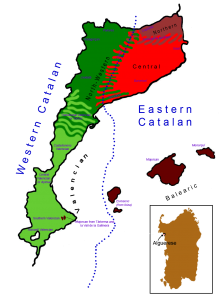 Why study Catalán?
Why study Catalán?
Catalan is a Romance language spoken by a population of around ten million people in the eastern part of the Iberian Peninsula (Catalonia, the Balearic Islands, most of the Valencia region, and the eastern fringe of Aragon) and the Principality of Andorra. In addition, Catalan is still spoken in the French region of Roussillon and the town of Alghero (L’Alguer) on the (Italian) island of Sardinia.
Catalan, like other Romance languages, evolved from Latin during the Middle Ages. The first written documents in Catalan are the Homilies d’Organyà, a compilation of sermons from the eleventh century. Throughout history, Catalan has endured as one of the languages of everyday use and literary expression in the eastern areas of the Iberian Peninsula. After a politically and culturally hegemonic period up to the sixteenth century, literary expression in Catalan experienced a decline until the nineteenth century, when, prompted by romantic ideals, there was a revival in the literary use of the language.
Catalan can be divided into two varieties: the western variety, spoken in Valencia, the western part of Catalonia, the eastern fringe of Aragon, and Andorra; and the eastern variety, spoken in the rest of Catalonia, the Balearic Islands, Roussillon, and L’Alguer. Today, Catalan is the co-official language, along with Spanish, in the Catalan-speaking areas of the Iberian Peninsula, and is the only official language of Andorra.
The prevalence of the Catalan language is best expressed. In 2012 almost 10 million people used Catalan as a primary language for communication. It is thus one of the top 100 most spoken languages in the world, and the fourteenth in the European Union. Catalan also placed twenty-seventh on the Steinke Index (2012), which measures the financial importance of a language. Its presence is between the tenth and twentieth of all languages found on the Internet (2012), and .cat was the first generic, top-level domain for a cultural and linguistic community (2005). Around the world there are more than 150 universities that teach Catalan.
The projection of the Catalan culture has many forms: from Futbol Club Barcelona to Salvador Dalí (1904–1989), through Joan Miró (1893–1983), Rafa Nadal, human castles, Pau Gasol, Melanie Costa-Schmid, Vicenç Ferrer Moncho (1920–2009), Pau Casals (1876–1973), Sergi López i Ayats, and Pep Guardiola. Beginning in the late nineteenth century, the Catalan-speaking areas became the focus of immigration and emigration. Regarding cultural production, there are several examples of successful professionals with non-Catalan origins, including the writers Ludwig Salvator of Austria (1847–1915), Matthew Tree from England, and Najat El Hachmi from Morocco.
There is also a presence of Catalan culture and heritage in the United States. Some examples from the eighteenth century include the Minorcan settlement in Florida; and Gaspar de Portolà de Rovira, explorer and founder of San Diego and Monterey, and the first governor of Alta California (1768–1770). In the 19th and 20th centuries, the majority of the Catalan heritage came to the United States through the Caribbean area. In fact, there is even a category in the US Census named Catalan American. The group is composed of Catalan-born naturalized citizens or residents, their descendants and, to a lesser extent, citizens or residents of Catalan descent who still acknowledge Catalan ancestry. The list of Catalan Americans includes a number of famous figures: the folk singer Nini Camps, the actress Patricia Clarkson, the actor Néstor Carbonell, the musician and cartoonist Xavier Cugat (1900–1990), the entertainer Manny Puig, the economist Xavier Sala-i-Martin, and the race car driver Oriol Servià.
There are several examples of American popular culture adapted to Catalan popular culture. Some examples from music are the 1868 popular song “Ten Little Injuns” (“John Brown era un petit indi” in Catalan) and the 1961 folk song “Puff, the Magic Dragon” (“Puff, el drac màgic”). On the other hand, the singer Lou Reed read some translated Catalan poems in 2007, and in 2012 the metal group Manowar made a speech in Barcelona in Catalan that lasted almost four minutes.
More about Catalán
target=”_blank” rel=”noopener”Generalitat Valenciana
North American Catalan Society